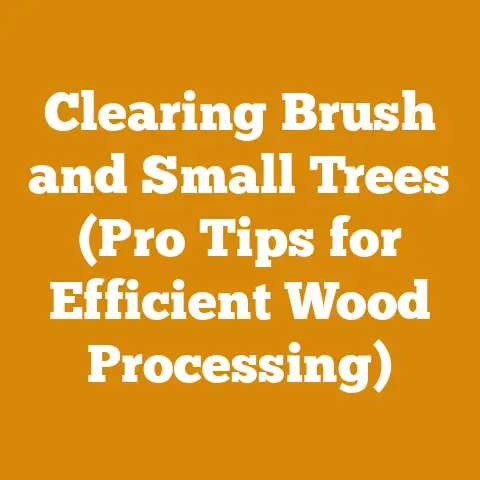Tree Stump Root Killer Tips (5 Pro Methods for Lasting Results)
Do you remember the old oak tree in your childhood backyard?
The one you climbed, built forts around, and carved your initials into?
It’s a sad day when such a majestic giant meets its end.
But even after the tree is gone, the stump remains, a stubborn reminder of what once was.
Getting rid of it can feel like an insurmountable task.
That’s why I’m diving into the world of tree stump root killers.
It’s a battle I’ve fought myself, more than once, and I’m here to share what I’ve learned about the costs, methods, and secrets to achieving lasting results.
Tree Stump Root Killer Tips (5 Pro Methods for Lasting Results)
Understanding the Stubbornness of Tree Stumps
Tree stumps are more than just an eyesore; they’re living organisms with extensive root systems.
These roots can continue to sprout new growth, attract pests, and even damage nearby structures.
Simply cutting down a tree leaves the root system intact, allowing it to persist and potentially regenerate.
The objective of using a root killer is to accelerate the decomposition of the stump and root system, preventing future growth and ultimately making the stump easier to remove.
The cost of ignoring a stump can be significant.
Uncontrolled growth can damage your lawn, garden, or even your home’s foundation.
Pests, like termites and ants, thrive in decaying wood, potentially spreading to your house.
And let’s not forget the tripping hazard, especially for kids playing in the yard.
I recall a time when I neglected a small apple tree stump in my orchard.
Within a year, it was sending up suckers all over the place, competing with my newly planted saplings.
I learned my lesson the hard way – a little preventative action goes a long way.
Method 1: The Chemical Warfare Approach – Root Killer Compounds
This is often the first method people consider, and for good reason.
Chemical root killers are readily available at most garden centers and hardware stores.
They work by introducing herbicides or other chemicals that kill the living tissue within the stump, accelerating its decomposition.
Understanding the Chemicals:
- Potassium Nitrate (KNO3): This is a common ingredient in many stump removers.
It acts as a fertilizer for fungi that break down the wood. - Sodium Metabisulfite (Na2S2O5): This chemical is more potent and works by poisoning the tree’s system.
It’s often used for larger, more stubborn stumps. - Glyphosate: A broad-spectrum herbicide, effective on many plant species.
However, use with caution as it can affect surrounding vegetation. - Triclopyr: Another systemic herbicide that’s particularly effective on woody plants.
Cost Analysis:
The cost of chemical root killers varies depending on the brand, concentration, and quantity.
Generally, you can expect to pay:
- Small container (1 lb): \$15 – \$30
- Large container (5 lbs): \$50 – \$100
These prices are based on averages from major retailers like Lowe’s, Home Depot, and Amazon, as of late 2024.
Prices can fluctuate based on supply chain issues and regional demand.
Application Process:
- Cut the Stump: Saw the stump as close to the ground as possible.
- Drill Holes: Drill several deep holes (10-12 inches) into the stump, focusing on the outer edges and the center.
The more holes, the better the chemical penetration.
I usually use a ¾ inch drill bit for this. - Pour the Chemical: Follow the manufacturer’s instructions.
Typically, you’ll pour the root killer granules or liquid into the holes.
For potassium nitrate products, you might mix the granules with water. - Water (If Necessary): Some products require watering to activate the chemical.
- Cover the Stump: Cover the stump with a tarp or plastic sheet to prevent rain from diluting the chemical and to keep pets or children away.
- Wait: This is the crucial part.
Depending on the size of the stump and the type of chemical used, it can take several weeks to several months for the stump to decompose.
Pros:
- Relatively easy to apply.
- Effective for many types of trees.
- Can be a cost-effective option for small to medium-sized stumps.
Cons:
- Can be harmful to the environment and surrounding plants if not used carefully.
- Takes time to work.
- May not be effective on all types of trees, especially those with very dense wood.
My Experience:
I once used a potassium nitrate-based stump remover on a stubborn oak stump.
It took almost six months for the stump to become soft enough to break apart with an axe.
Patience is key!
I also made sure to thoroughly water the area around the stump after application to dilute any potential runoff.
Method 2: The Natural Decomposition Route – Epsom Salt and Elbow Grease
For those who prefer a more environmentally friendly approach, Epsom salt can be a viable alternative to chemical root killers.
Epsom salt (magnesium sulfate) draws moisture out of the wood, creating an inhospitable environment for the tree and promoting decomposition.
Cost Analysis:
Epsom salt is relatively inexpensive and readily available at most pharmacies, grocery stores, and garden centers.
- Small bag (4 lbs): \$5 – \$10
- Large bag (25 lbs): \$20 – \$35
These prices are based on averages from major retailers as of late 2024.
Bulk purchases often offer significant savings.
Application Process:
- Cut the Stump: As with the chemical method, cut the stump as close to the ground as possible.
- Drill Holes: Drill numerous deep holes into the stump, similar to the chemical method.
- Fill with Epsom Salt: Pack the holes tightly with Epsom salt.
- Water: Add water to dissolve the Epsom salt and help it penetrate the wood.
- Cover (Optional): Covering the stump with a tarp can help retain moisture and speed up the decomposition process.
- Wait: This method also requires patience.
It can take several months to a year for the stump to decompose significantly.
Pros:
- Environmentally friendly.
- Relatively inexpensive.
- Easy to apply.
Cons:
- Takes a long time to work.
- May not be as effective as chemical root killers on very large or dense stumps.
- Requires regular watering.
My Experience:
I used Epsom salt to decompose a small cherry tree stump.
It took almost a year, but eventually, the stump became soft and crumbly enough to remove with a shovel and pickaxe.
The key is to keep the stump consistently moist.
I watered it every few weeks, especially during dry periods.
Method 3: The Burning Man (or Woman) Approach – Controlled Burning (Where Permitted)
This method involves burning the stump down to the ground.
However, it’s crucial to emphasize that controlled burning should only be attempted where it is legal and safe to do so.
Check local regulations and obtain any necessary permits before proceeding.
Fire safety precautions are paramount.
Cost Analysis:
The cost of burning a stump primarily involves the materials needed to start and maintain the fire.
- Firewood/Kindling: \$20 – \$50 (depending on the amount needed)
- Kerosene/Starter Fluid: \$10 – \$20
- Safety Equipment (gloves, eye protection, shovel): \$20 – \$50 (if you don’t already own these)
Application Process:
- Clear the Area: Clear a wide area (at least 10 feet) around the stump of any flammable materials, such as dry leaves, grass, or branches.
- Build a Fire: Build a fire on top of the stump, using firewood, kindling, and starter fluid.
- Maintain the Fire: Keep the fire burning continuously until the stump is burned down to the ground.
This may require adding more firewood periodically. - Extinguish the Embers: Once the stump is burned, thoroughly extinguish any remaining embers with water.
- Fill the Hole: Fill the hole with soil and topsoil.
Pros:
- Relatively fast.
- Effective for removing large stumps.
- Can be a cost-effective option if you have access to free firewood.
Cons:
- Potentially dangerous.
- Requires careful monitoring.
- May not be legal in all areas.
- Can create a significant amount of smoke.
My Experience:
I once helped a neighbor burn down a large pine stump in a rural area where burning was permitted.
We built a large fire on top of the stump and kept it burning for several days.
It was a lot of work, but eventually, the stump was completely gone.
We took extra precautions to prevent the fire from spreading, including having a water hose nearby and constantly monitoring the flames.
Method 4: The Grinding Game – Stump Grinding Services
Stump grinding involves using a specialized machine to grind the stump down into small wood chips.
This method is faster and more effective than manual removal and avoids the use of chemicals or fire.
Cost Analysis:
Stump grinding services are typically priced by the inch of stump diameter.
The average cost ranges from:
- \$3 – \$8 per inch of diameter.
So, for example, a 20-inch diameter stump could cost between \$60 and \$160 to grind.
Some companies also charge a minimum service fee, which can range from \$75 to \$150.
Other factors that can affect the cost include:
- Accessibility: If the stump is difficult to access, the price may be higher.
- Number of Stumps: Some companies offer discounts for grinding multiple stumps.
- Location: Prices may vary depending on your geographic location and the local market rates.
- Root chasing: Grinding the visible roots extending out from the stump also increases the price.
I recommend getting quotes from at least three different stump grinding services to compare prices and services offered.
Application Process:
- Contact a Stump Grinding Service: Research and contact local stump grinding companies to get quotes.
- Schedule an Appointment: Once you’ve chosen a company, schedule an appointment for them to come and grind the stump.
- Prepare the Area: Clear any obstacles around the stump, such as rocks, debris, or landscaping.
- Stump Grinding: The stump grinding technician will use a specialized machine to grind the stump down into wood chips.
- Clean Up: The technician will typically clean up the wood chips and debris after the stump is ground.
You can then use the wood chips as mulch or dispose of them.
Pros:
- Fast and efficient.
- Avoids the use of chemicals or fire.
- Leaves the area relatively clean.
Cons:
- Can be expensive.
- Requires hiring a professional service.
- May not be suitable for stumps in very tight spaces.
My Experience:
I hired a stump grinding service to remove a large maple stump in my backyard.
It was the most expensive option, but it was also the fastest and easiest.
The technician arrived on time, ground the stump down in about an hour, and cleaned up the area perfectly.
I used the wood chips as mulch in my garden, which was a nice bonus.
Case Study:
A homeowner in Portland, Oregon, had three tree stumps of varying sizes (12 inches, 18 inches, and 24 inches in diameter).
They received quotes from three different stump grinding companies:
- Company A: \$5 per inch, minimum \$100 fee = \$ (12×5) + (18×5) + (24×5) = \$270
- Company B: \$4 per inch, no minimum fee = \$ (12×4) + (18×4) + (24×4) = \$216
- Company C: \$6 per inch, minimum \$150 fee = \$ (12×6) + (18×6) + (24×6) = \$324
The homeowner chose Company B because it offered the lowest overall price and didn’t have a minimum fee.
Method 5: The Manual Labor of Love (or Hate) – Digging It Out
This is the most labor-intensive method, involving digging around the stump and severing the roots with an axe or saw.
It’s best suited for smaller stumps and those with relatively shallow root systems.
I can tell you from experience, this method builds character and muscles!
Cost Analysis:
The cost of manual stump removal primarily involves the tools needed.
- Shovel: \$20 – \$40
- Axe/Saw: \$30 – \$100 (depending on the quality and type)
- Pickaxe: \$30 – \$60
- Gloves: \$10 – \$20
- Root Saw: \$50 – \$150
- Wheelbarrow: \$80 – \$200 (to haul away the stump and roots)
Application Process:
- Dig Around the Stump: Dig a wide circle around the stump, exposing the main roots.
- Sever the Roots: Use an axe or saw to sever the roots as you expose them.
A reciprocating saw with a demolition blade or a specialized root saw works wonders. - Wiggle and Pull: Once you’ve severed most of the roots, try to wiggle and pull the stump out of the ground.
You may need to use a pry bar or winch for larger stumps. - Remove Remaining Roots: Remove any remaining roots from the hole.
- Fill the Hole: Fill the hole with soil and topsoil.
Pros:
- No chemicals or fire.
- Can be a good workout.
- Relatively inexpensive if you already own the necessary tools.
Cons:
- Extremely labor-intensive.
- Time-consuming.
- May not be feasible for large or deeply rooted stumps.
My Experience:
I once spent an entire weekend digging out a small pine stump by hand.
It was back-breaking work, but I felt a great sense of accomplishment when I finally got it out.
I used a combination of a shovel, axe, and pickaxe.
The key is to be patient and persistent.
Also, make sure to wear gloves to protect your hands from blisters.
Tip: Soaking the ground around the stump with water for a day or two before digging can make the soil easier to work with.
Additional Cost Considerations
Beyond the direct costs of each method, there are several other factors that can affect the overall cost of stump removal:
- Permits: Some municipalities require permits for tree removal or stump grinding.
Check with your local authorities to determine if any permits are required and what the associated fees are. - Disposal Fees: If you choose to remove the stump yourself, you’ll need to dispose of the stump and roots.
Disposal fees at landfills or recycling centers can vary depending on the size and weight of the material. - Landscaping Costs: After the stump is removed, you may need to repair or re-landscape the area.
This can include costs for soil, topsoil, grass seed, sod, or other landscaping materials. - Equipment Rental: If you don’t own the necessary tools, you may need to rent them.
Rental costs for equipment like stump grinders, chainsaws, and excavators can add up quickly. - Travel Costs: If you hire a stump grinding service, factor in any travel fees or surcharges that may apply.
- Hidden Roots: Sometimes, the root system extends far beyond what’s visible on the surface.
Dealing with extensive, hidden roots can increase the time and cost of removal.
Optimizing Your Budget: Tips and Tricks
- DIY vs.
Professional: Carefully weigh the costs and benefits of DIY stump removal versus hiring a professional service.
Consider your physical abilities, time constraints, and the size and location of the stump. - Compare Quotes: Get quotes from multiple stump grinding services to ensure you’re getting the best price.
- Bundle Services: Some companies offer discounts for bundling stump grinding with other services, such as tree trimming or removal.
- Rent Equipment: If you’re comfortable operating heavy machinery, renting a stump grinder can be a cost-effective option.
- Use Free Resources: Take advantage of free resources, such as online tutorials and local extension offices, to learn more about stump removal techniques.
- Consider the Long Term: Don’t just focus on the immediate cost of stump removal.
Consider the long-term costs of leaving the stump in place, such as potential damage to your property or the spread of pests. - Salvage the Wood: Depending on the type of tree, you may be able to salvage the wood for firewood or other projects.
- Negotiate: Don’t be afraid to negotiate with stump grinding services or equipment rental companies to get a better price.
- Plan Ahead: Start planning your stump removal project well in advance to give yourself time to research options, compare prices, and gather the necessary materials.
Calculations and Formulas
- Estimating Stump Volume: To estimate the volume of a stump, you can use the formula for the volume of a cylinder: V = πr²h, where V is the volume, π is pi (approximately 3.14), r is the radius of the stump (half of the diameter), and h is the height of the stump.
This can help you estimate the amount of chemical root killer or Epsom salt you’ll need. - Board Feet Calculation: If you plan to salvage the wood from the stump, you can estimate the number of board feet using the following formula: Board Feet = (Thickness in inches x Width in inches x Length in feet) / 12.
- Moisture Content Calculation: To determine the moisture content of the wood, you can use a moisture meter or calculate it manually using the following formula: Moisture Content (%) = ((Wet Weight – Dry Weight) / Dry Weight) x 100.
This is important if you plan to use the wood for firewood.
Current Industry Benchmarks and Statistical Data
- Average Price per Cord of Firewood: According to the U.S.
Energy Information Administration, the average price per cord of firewood in the United States ranges from \$200 to \$400, depending on the location, wood type, and demand. - Average Stump Grinding Cost: As mentioned earlier, the average cost of stump grinding ranges from \$3 to \$8 per inch of diameter.
- Timber Prices: Timber prices vary widely depending on the species, quality, and location.
You can find current timber prices from sources like the U.S.
Forest Service and state forestry agencies.
Conclusion: The Root of the Matter
Removing a tree stump can be a daunting task, but with the right knowledge and approach, it’s definitely achievable.
Whether you choose the chemical warfare approach, the natural decomposition route, the burning man method, the grinding game, or the manual labor of love, understanding the costs, pros, and cons of each method is crucial for making an informed decision.
Remember to factor in all the additional cost considerations, such as permits, disposal fees, and landscaping costs.
And don’t forget to optimize your budget by comparing quotes, renting equipment, and taking advantage of free resources.
No matter which method you choose, patience and persistence are key.
Removing a tree stump takes time and effort, but the results are well worth it.
A clean, stump-free yard is not only more aesthetically pleasing but also safer and more functional.
So, roll up your sleeves, gather your tools, and get ready to tackle that stubborn stump.
With a little hard work and the right approach, you’ll be well on your way to a stump-free paradise!
And who knows, maybe you’ll even build some character along the way, just like I did.






